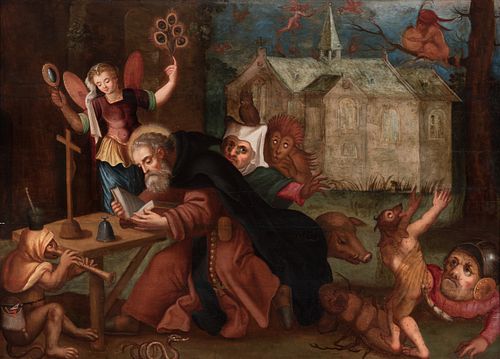Flemish school. Follower of EL BOSCO, XVI century. "Temptations of St. Anthony". Oil on panel (seamed).
Lot 136
About Seller
Setdart Auction House
Carrer Aragó 346
Barcelona
Spain
Setdart Subastas was born in 2004 and is currently the first online art auction in Spain with solidity, prestige and reliability guaranteed by our more than 60,000 users. Setdart has a young, dynamic and enterprising team ready to successfully manage the purchase and sale of art works through custom...Read more
Estimate:
EUR€14,000 - EUR€15,000
$15,217.39 - $16,304.35
Absentee vs Live bid
Two ways to bid:
- Leave a max absentee bid and the platform will bid on your behalf up to your maximum bid during the live auction.
- Bid live during the auction and your bids will be submitted real-time to the auctioneer.
Bid Increments
| Price | Bid Increment |
|---|---|
| EUR€0 | EUR€10 |
| EUR€200 | EUR€25 |
| EUR€500 | EUR€50 |
| EUR€1,000 | EUR€100 |
| EUR€3,000 | EUR€200 |
| EUR€5,000 | EUR€500 |
| EUR€10,000 | EUR€1,000 |
| EUR€20,000 | EUR€2,000 |
| EUR€50,000 | EUR€5,000 |
About Auction
By Setdart Auction House
Jul 14, 2021
Set Reminder
2021-07-14 06:30:00
2021-07-14 06:30:00
America/New_York
Bidsquare
Bidsquare : OLD MASTERS
https://www.bidsquare.com/auctions/setdart-auction-house/old-masters-7202
Setdart Auction House sofia@setdart.com
Setdart Auction House sofia@setdart.com
- Lot Description
Flemish school. Follower of EL BOSCO, XVI century. "Temptations of St. Anthony". Oil on panel (seamed). Measures: 75,5 x 106 cm.; 101 x 130 cm. (frame). The story of the Christian monk who decided to withdraw from society and live secluded in the desert appeared in "The Golden Legend" of Santiago de la Vorágine, a religious text of the thirteenth century, which was one of the most important influences on the painting of the Middle Ages and the Renaissance, especially in Flemish art. Hieronymus Bosch and his followers treated the subject on numerous occasions, allowing them to explore their imagination in the characterization of demonic characters, often shown as hybrids between the animal and the human, or also represented in symbiosis with the vegetable element, and a host of grotesque creatures. The influence of Hieronymus Bosch is notable in the present panel, from the late Renaissance period: fantastic flying creatures, demons playing instruments (in one of them, the trumpet extends its snout, as if it were part of it), a bestialized soldier, a human with the head and tail of a wolf.... All this gallery of temptations fails to incite St. Anthony, who remains absorbed in front of the cross and the book of the Gospels, and next to an archangel under whose protection he takes shelter. The pig, attribute of the saint, lowers his gaze to the ground trying not to look at this parade of evil creatures. In composition and creativity expressed in each of the figures we see the influence of Bosch: the triptych of the Temptations (preserved in the National Museum of Ancient Art in Lisbon), or the two panels preserved in the Prado Museum. This is a piece of great quality, made by a Flemish painter who draws on the rich legacy of his predecessors, but also of his contemporaries, such as Brueghel the Elder.
- Shipping Info
-
In-house shipping available. Please inquire at admin@setdart.com.
-
- Buyer's Premium



 EUR
EUR CAD
CAD AUD
AUD GBP
GBP MXN
MXN HKD
HKD CNY
CNY MYR
MYR SEK
SEK SGD
SGD CHF
CHF THB
THB

















